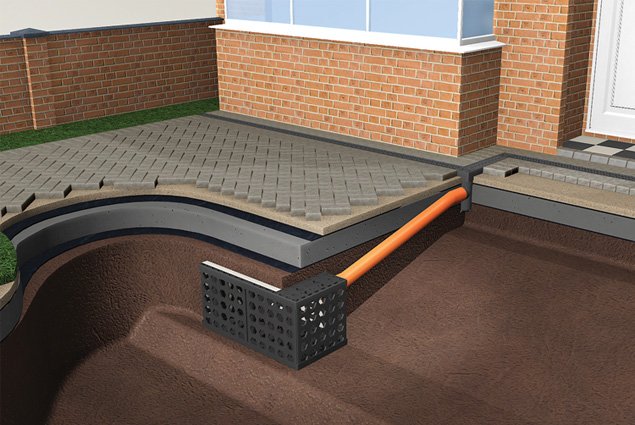A soakaway is a drainage feature buried underground to manage surface water in your drainage system.
They are often found in open spaces, such as gardens and car parks, as they’re easier to maintain and offer less interference with building foundations.
To install a soakaway, the ground needs excavating first.
Geo-cellular soakaway crates can be used to store surface water and, thanks to their modular design, they can be tailored to suit your specific requirements.
Stone and rubble are typically laid at the bottom of the soakaway, enabling water to filtrate at a steady rate while ensuring pollutants don’t infiltrate the soil.
Below, we’ll assess the pros and cons of installing a soakaway.
The advantages of a soakaway
There are a number of ways in which you and your property can benefit from installing a soakaway.
These include:
- Low maintenance
The purpose of a soakaway is to collect and store the surface water from around your property to prevent pooling and flooding.
To ensure your system functions efficiently, you need to check and maintain it properly. And that generally involves removing the lid every three months or so, lifting out and emptying the silt bucket before replacing it.
If you notice water pooling around pipes and gullies or the ground is more saturated than usual, this indicates your soakaway may be blocked. But don’t panic – high-pressure jets can be used to safely clear plastic soakaway crates.
- Easy to install
The process of installing a soakaway is relatively straightforward once you know how.
A percolation test will need to be carried out to establish what type of soil you have and if it’s suitable for building a soakaway system.
Heavy clay soils are impermeable and won’t allow water to drain through properly, rendering the soakaway useless. Ideally, you want to install crates in sand or loamy soils to maximise efficiency.
After determining if you have the right soil, the next step is to dig a trench big enough for your soakaway crates, base, back and side fill.
Then, you’ll need to assemble the crates and wrap them in a geotextile membrane before lowering them into the pit and feeding the pipe into the system.
- Cost-effective
Soakaway crates offer a cost-effective solution for reducing the risk of flooding by taking surface water away from the sewer.
This helps to sustain the life of your garden and can prevent dampness inside your property.
A soakaway can also boost natural absorption and last up to 100 years with the right care.
The disadvantages of a soakaway
There are a couple of downsides to soakaway systems you need to be aware of, including:
- Planning
Unfortunately, soakaway crates are not suitable for areas with poorly drained soils or where infiltration water may interfere with building foundations.
Field investigations and long-term groundwater monitoring will be required to confirm infiltration rates prior to the installation of a soakaway system.
- Blockages
Soakaways can accumulate dirt and leaves if they’re not fitted with a silt filter.
Allowing silt to build up can reduce the soakaway’s capacity, preventing surface water from being collected and percolated back into the soil. This can lead to inefficient drainage and potential waterlogging.
- Repairs
One of the biggest drawbacks of soakaway systems is that they are often irreparable. If it fails or becomes damaged over time, you’ll likely need to replace it with a new one.
While it’s impossible to predict the exact lifespan of a soakaway, frequent maintenance inspections will help to increase its longevity.
Find out more about soakaways
If you’re undecided whether a soakaway is an effective installation for you, it’s worth seeking professional advice so you can assess the pros and cons in further detail.
If you opt to install a new system, make sure you go to a reputable supplier for your soakaway crates.
Cotterill Civils stock crates in an extensive range of sizes, all of which are lightweight and easy to handle. Their team can even install soakaway crates on your behalf, giving you the peace of mind that they’re installed correctly and will last as long as possible.

